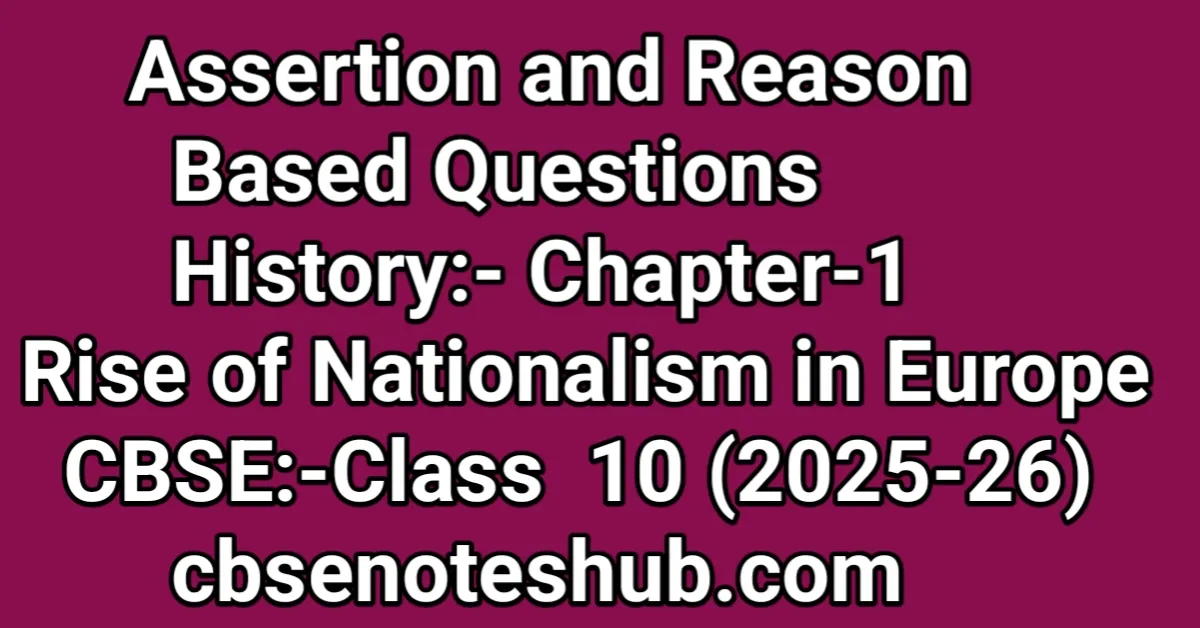This post gives you an in-depth understanding of Assertion and Reason-based Questions from Chapter 1 – Rise of Nationalism in Europe (History, Class 10), helping you revise effectively and strengthen your concepts for exams.
Assertion and Reason Based Questions
Class: 10th History Chapter: 1 — Rise of Nationalism in Europe
In the questions given below, there are two statements marked as Assertion (A) and Reason (R). Read the statements and choose the correct option.
Q.1. Assertion (A): Conservatism was opposed to monarchy.
Reason (R): Conservatism supported strong army and efficient bureaucracy.
Ans. (iv) A is false but R is true.Q.2. Assertion (A): Treaty of Vienna marked the beginning of new conservatism in Europe.
Reason (R): The Vienna Congress was meant to undo the changes made by the Napoleonic regime.
Ans. (ii) Both A and R are true but R is not the correct explanation of the assertion.Q.3. Assertion (A): French Revolution was the first clear expression of nationalism in Europe.
Reason (R): Revolutionists tried to create a sense of collective identity among the people.
Ans. (i) Both A and R are true and R is correct explanation of the assertion.Q.4. Assertion (A): Liberal nationalism advocated universal adult franchise.
Reason (R): Liberal nationalists were supportive of equality before law.
Ans. (iv) A is false but R is true.Q.5. Assertion (A): The 1830s were years of economic hardship in Europe.
Reason (R): Europe witnessed a sudden rise in population in the 1830s and the number of job seekers increased.
Ans. (i) Both A and R are true and R is the correct explanation of A.Q.6. Assertion (A): In the areas conquered by Napoleon, the reaction of the local population was mixed.
Reason (R): Increased taxation and censorship outweighed the advantages of administrative changes.
Ans. (i) Both A and R are true and R is correct explanation of A.Q.7. Assertion (A): Conservatives believed that the established traditional society should be preserved.
Reason (R): Zollverein was formed to preserve conservatism.
Ans. (iii) A is true but R is false.Q.8. Assertion (A): The Treaty of Constantinople was signed in 1832.
Reason (R): Under this treaty Greece was recognised as an independent nation.
Ans. (i) Both A and R are true and R is correct explanation of A.
📘 Must Read:
Q.9. Assertion (A): Act of Union was signed between England and Scotland.
Reason (R): The object of the Act was to undo changes that had come up in Europe during the Napoleonic wars.
Ans. (iii) A is true but R is false.Q.10. Assertion (A): Ideas of national unity in early-nineteenth-century Europe were closely allied to the ideology of liberalism.
Reason (R): In 1834, a customs union or Zollverein was formed at the initiative of Prussia.
Ans. (i) Both A and R are true and R is the correct explanation of A.Q.11. Assertion (A): In 1834, Zollverein was formed at the initiative of Prussia.
Reason (R): The basic aim was to transfer sovereignty from the monarchy to a body of citizens.
Ans. (iii) A is true but R is false.Q.12. Assertion (A): The first clear expression of nationalism came with the French Revolution in 1789.
Reason (R): The Act of Union between England and Scotland resulted in the formation of the United Kingdom.
Ans. (ii) Both A and R are true but R is not the correct explanation of A.Q.13. Assertion (A): Female allegories were invented by artists in the 19th century.
Reason (R): These were to represent the nation.
Ans. (i) Both A and R are true and R is the correct explanation of A.Q.14. Assertion (A): In 1815, representatives of the European powers—Britain, Russia, Prussia and Austria—met at Vienna.
Reason (R): The European powers met to draw up a settlement for Europe.
Ans. (i) Both A and R are true and R is the correct explanation of A.Q.15. Assertion (A): Conservative regimes set up in 1815 were democratic.
Reason (R): They did not tolerate criticism and dissent.
Ans. (iv) A is false but R is true.Q.16. Assertion (A): The most serious source of nationalist tension in Europe after 1871 was the Balkans.
Reason (R): The spread of the ideas of romantic nationalism, together with the disintegration of the Ottoman Empire, made this region very explosive.
Ans. (i) Both A and R are true and R is the correct explanation of A.
Source: NCERT

